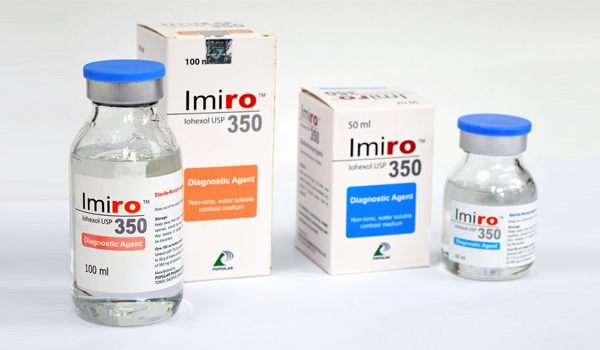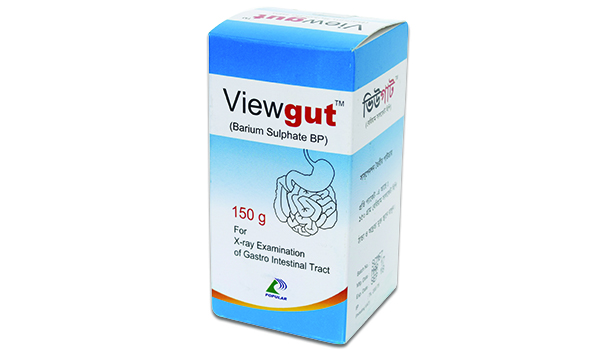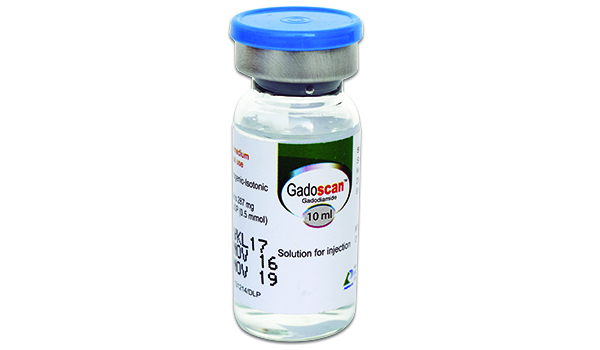Indication
Iohexol is an X-ray contrast medium for use in adults and children for cardioangiography, arteriography, urography, phlebography and CT-enhancement. Lumbar, thoracic, cervical myelography and computed tomography of the basal cisterns, following subarachnoid injection. It is also indicated for arthrography, endoscopic retrograde pancreatography (ERP), endoscopic retrograde cholangiopancreatography (ERCP), herniography, hysterosalpingography, sialography and studies of the gastrointestinal tract when the use of barium sulphate is unsatisfactory, undesirable or contraindicated.
Dosage & Administration
The dosage varies depending on the type of examination, age, weight, cardiac output and general condition of the patient and the technique used. Usually the same iodine concentration and volume is used as with other iodinated X-ray contrast media in current use. Adequate hydration should be assured before and after administration as for other contrast media.
The following dosages may serve as a guide
| Indication | Concentration | Volume | Comments |
|---|---|---|---|
| Urography adults children < 7 kg children > 7 kg |
300 mg l/ml or 350 mg l/ml 240 mg l/ml or 300 mg l/ml or 350 mg l/ml 240 mg l/ml or 300 mg l/ml |
40 - 80 ml 40 - 80 ml 4 ml/kg 3 ml/kg 3 ml/kg 2 ml/kg (max 40 ml) |
80 ml may be exceeded in selected cases |
| Phlebography (leg) | 240 mg l/ml or 300 mg l/ml |
20 - 100 ml/leg | |
| Digital subtraction angiography |
300 mg l/ml or 350 mg l/ml |
20-60 ml/inj. 20-60 ml/inj. |
|
| CT-enheancemen adults: Children: |
140 mg l/ml or 240 mg l/ml or 300 mg l/ml or 350 mg l/ml 240 mg l/ml or 300 mg l/ml |
100 - 400 ml 100 - 250 ml 100 - 200 ml 100 - 150 ml 2-3 ml/kg b.w. up to 40ml 1-3 ml/kg b.w. up to 40ml |
Total amount of iodine is usually 30-60g In a few cases up to 100 ml may be given |
Guidelines for Intra-arterial use
| Indication | Concentration | Volume | Comments |
|---|---|---|---|
| Arteriographies arch aortography selective cerebral aortography femoral various |
300 mg l/ml 300 mg l/ml 350 mg l/ml 300 mg l/ml or 350 mg l/ml 300 mg l/ml |
30 - 40 ml/inj 5 - 10 ml/inj 40 - 60 ml/inj 30 - 50 ml/inj depending on type of examination |
Volumn per injection depends on the site of injection |
| Cardioangiography adults: left ventricle and aortic root inj. selective coronary arteriography children: |
350 mg l/ml 350 mg l/ml 300 mg l/ml or 350 mg l/ml |
30 - 60 ml/inj 4 - 8 ml/inj depending on age, weight and pathology (max 8 ml/kg b.w.) |
|
| Digital subtraction angiography | 140 mg l/ml or 240 mg l/ml or 300 mg l/ml |
1 - 15 ml/inj 1 - 15 ml/inj 1 - 15 ml/inj |
depending on site of inj. occasionally large volumes - up to 30 ml - may be used |
Guidelines for Intrathecal use
| Indication | Concentration | Volume | Comments |
|---|---|---|---|
| Lumbar and thoracic myelography ( lumber injection ) Cervical myelography ( lumber injection ) Cervical myelography ( lumber Cervical injection ) CT cistemography ( lumber injection ) |
180 mg l/ml or 240 mg l/ml 240 mg l/ml or 300 mg l/ml 240 mg l/ml or 300 mg l/ml 180 mg l/ml or 240 mg l/ml |
10 - 15 ml 8 - 12 ml 10 - 12 ml 7 - 10 ml 6 - 10 ml 6 - 8 ml 5 - 15 ml 4 - 12 ml |
|
| Paediatric myelography <2 years 2-6 years >6 years |
180 mg l/ml 180 mg l/ml 180 mg l/ml |
2 - 6 ml 4 - 8 ml 6 - 12 ml |
To minimize possible adverse reactions a total dose of 3 g iodine should not be exceeded.
Guidelines for Body Cavities:
| Indication | Concentration | Volume | Comments |
|---|---|---|---|
| Arthrography Adults: |
200 mg l/ml or 240 mg l/ml or 300 mg l/ml or 350 mg l/ml |
5-20 ml 5-20 ml 5-15 ml 5-10 ml |
|
| ERP/ERCP | 240 mg l/ml | 20-50 ml | |
| Hemiography | 240 mg l/ml | 50 ml | The dosage varies with the size of |
| Hysterosalpingography | 240 mg l/ml 300 mg l/ml |
15-20 ml 15-20 ml |
The hernia |
| Sialography | 240 mg l/ml or 300 mg l/ml |
0.5-2 ml 0.5-2 ml |
|
| Gastrointestinal Studies Oral Use: Adults Children: -oesophagus -ventricle/follow through Prematures Rectal Use: Children |
180 mg l/ml or 200 mg l/ml or 300 mg l/ml 300 mg l/ml or 350 mg l/ml 140 mg l/ml 350 mg l/ml 140 mg l/ml or dilute with tap water to 100-150 mg l/ml |
Individual Individual Individual 2-4 ml/kg b.w. 2-4 ml/kg b.w. 4-5 ml/kg b.w. 2-4 ml/kg b.w. 5-10 ml/kg b.w. 5-10 ml/kg b.w. |
Max. dose 50 ml Max. dose 50 ml Example:Dilute lohexol 240, 300 or 350 with tap-water 1:1 or 1:2 |
| CT-enhancement Oral Use: Adults Children Rectal Use: Children |
Dilute with tap water to ~6 mg l/ml Dilute with tap water to ~6 mg l/ml Dilute with tap water to ~6 mg l/ml |
800-2000 ml of the diluted solution over a period of time. 15-20 mL/kg b.w. of the diluted solution:Individual |
Example:Dilute lohexol 300 or 350 with tap-water 1:50 |
Precautions
Special precautions for use of non-ionic monomeric contrast media in general: A positive history of allergy, asthma, or untoward reactions to iodinated contrast media indicates a need for special caution. Premedication with corticosteroids or histamine H1 and H2 antagonists might be considered in these cases. The risk of serious reactions in connection with use of Iohexol is regarded as minor. However, iodinated contrast media may provoke anaphylactoid reactions or other manifestations of hypersensitivity. A course of action should therefore be planned in advance, with necessary drugs and equipment available for immediate treatment, should a serious reaction occur. It is advisable always to use an indwelling cannula or catheter for quick intravenous access throughout the entire X-ray procedure. Non-ionic contrast media have less effect on the coagulation system in vitro, compared to ionic contrast media. When performing vascular catheterisation procedures one should pay meticulous attention to the angiographic technique and flush the catheter frequently (e.g.: with heparinised saline) so as to minimise the risk of procedure-related thrombosis and embolism. Adequate hydration should be assured before and after contrast media administration. This applies especially to patients with multiple myeloma, diabetes mellitus, renal dysfunction, as well as to infants, small children and elderly patients. Young infants (age<1 year) and especially neonates are susceptible to electrolyte disturbance and haemodynamic alterations. Care should also be taken in patients with serious cardiac disease and pulmonary hypertension as they may develop haemodynamic changes or arrhythmias. Patients with acute cerebral pathology, tumours or a history of epilepsy are predisposed for seizures and merit particular care. Also alcoholics and drug addicts have an increased risk for seizures and neurological reactions. A few patients have experienced a temporary hearing loss or even deafness after myelography, which is believed to be due to a drop in spinal fluid pressure by the lumbar puncture per se. To prevent acute renal failure following contrast media administration, special care should be exercised in patients with pre-existing renal impairment and diabetes mellitus as they are at risk. Patients with paraproteinemias (myelomatosis and Waldenström\'s macroglobulinemia) are also at risk. Preventive measures include:
- Identification of high risk patients.
- Ensuring adequate hydration. If necessary by maintaining an i.v. infusion from before the procedure until the contrast medium has been cleared by the kidneys.
- Avoiding additional strain on the kidneys in the form of nephrotoxic drugs, oral cholecystographic agents, arterial clamping, renal arterial angioplasty, or major surgery, until the contrast medium has been cleared.
- Postponing a repeat contrast medium examination until renal function returns to pre-examination levels.
To prevent lactic acidosis, serum creatinine level should be measured in diabetic patients treated with metformin prior to intravascular administration of iodinated contrast medium. Normal serum creatinine / renal function: Administration of metformin should be stopped at the time of administration of contrast medium and not resumed for 48 hours or until renal function / serum creatinine is normal. Abnormal serum creatinine / renal function: Metformin should be stopped and the contrast medium examination delayed for 48 hours. Metformin should only be restarted if renal function / serum creatinine is unchanged. In emergency cases where renal function is abnormal or unknown, the physician should evaluate the risk / benefit of the contrast medium examination, and precautions should be implemented: Metformin should be stopped, patient hydrated, renal function monitored and patient observed for symptoms of lactic acidosis. A potential risk of transient hepatic dysfunction exists. Particular care is required in patients with severe disturbance of both renal and hepatic function, as they may have significantly delayed contrast medium clearance. Patients on haemodialysis may receive contrast media for radiological procedures. Correlation of the time of contrast media injection with the haemodialysis session is unnecessary. The administration of iodinated contrast media may aggravate the symptoms of myasthenia gravis. In patients with phaeochromocytoma undergoing interventional procedures, alpha blockers should be given as prophylaxis to avoid a hypertensive crisis. Special care should be exercised in patients with hyperthyroidism. Patients with multinodular goitre may be at risk of developing hyperthyroidism following injection of iodinated contrast media. One should also be aware of the possibility of inducing transient hypothyroidism in premature infants receiving contrast media. Extravasation of contrast media may on rare occasions give rise to local pain, and oedema, which usually recedes without sequelae. However, inflammation and even tissue necrosis have been seen. Elevating and cooling the affected site is recommended as routine measures. Surgical decompression may be necessary in cases of compartment syndrome.




